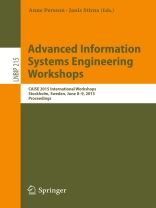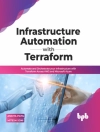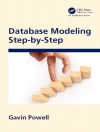This book constitutes the thoroughly refereed proceedings of seven international workshops held in Stockholm, Sweden, in conjunction with the 27th International Conference on Advanced Information Systems Engineering, CAi SE 2015, in June 2015.The 38 full and nine short papers were carefully selected from 107 submissions.The workshops were the Second International Workshop on Advances in Services Design based on the Notion of Capability (ASDENCA), the Third International Workshop on Cognitive Aspects of Information Systems Engineering (COGNISE), the First International Workshop on Digital Business Innovation and the Future Enterprise Information Systems Engineering (Di Fen SE), the First International Workshop on Enterprise Modeling (EM), the First Workshop on the Role of Real-World Objects in Business Process Management Systems (RW-BPMS), the 10th International Workshop on Trends in Enterprise Architecture Research (TEAR), and the 5th International Workshop on Information Systems Security Engineering (WISSE).
İçerik tablosu
ASDENCA 2015.- Investigating the Potential of Capability-Driven Design and Delivery in an SME Case Study.- Advanced Context Processing for Business Process Execution Adjustment.- Strategies for Capability Modelling: Analysis Based on Initial Experiences.- Analyzing IT Flexibility to Enable Dynamic Capabilities.- COGNISE 2015.- Towards Guiding Process Modelers Depending upon Their Expertise Levels.- How Does It Look? Exploring Meaningful Layout Features of Process Models.- Advanced Dynamic Role Resolution in Business Processes.- A Position Paper Proposing Behavioral Solutions to Challenges in Software Development Projects.- To Document or Not to Document? An Exploratory Study on Developers’ Motivation to Document Code.- When a Paradigm is Inconsistent with Intuition: The Case of Inconsistency Management.- An Argument for More User-Centric Analysis of Modeling Languages’ Visual Notation Quality.- Di Fen SE 2015.- Some Heuristics for Digital Business Model Configuration.- Inherent Cognitive Dependencies in the Transformation of Business Models from Non-digital to Digital.- Capability-as-a-Service: Investigating the Innovation Potential from a Business Model Perspective.- Supporting Service Innovation Through a Value Development Framework.- Designing Software Ecosystems: How to Develop Sustainable Collaborations?: Scenarios from Apple i OS and Google Android.- Fitness of Business Models for Digital Collaborative Platforms in Clusters: A Case Study.- Accelerating Web-Entrepreneurship in Local Incubation Environments.- Challenges Laying Ahead for Future Digital Enterprises: A Research Perspective.- EM 2015.- Ontology-Driven Enterprise Modelling in Practice: Experiences from Industrial Cases.- Extending Enterprise Architectures to Capture Consumer Values: The Case of TOGAF.- The Devil in the Details: Fine-Grained Enterprise Model Weaving.- Extending Feature Models to Express Variability in Business Process Models.- Enterprise Architecture for Business Network Planning: A Capability-Based Approach.- Towards Flexible and Efficient Process and Workflow Support in Enterprise Modeling.- RW-BPMS 2015.- The Things of the Internet of Things in BPMN.- Applying Process Mining to Smart Spaces: Perspectives and Research Challenges.- Factors Affecting Ocean-Going Cargo Ship Speed and Arrival Time.- Monitoring Batch Regions in Business Processes.- TEAR 2015.- Revealing Hidden Structures in Organizational Transformation – A Case Study.- Enterprise Architecture with Executable Modelling Rules: A Case Study at the Swedish Defence Materiel Administration.- Modeling Decisions for Collaborative Enterprise Architecture Engineering.- Towards an Enterprise Architecture Benefits Measurement Instrument.- Modelling Value with Archi Mate.- Implementing Architectural Thinking: A Case Study at Commerzbank AG.- Data Governance on EA Information Assets: Logical Reasoning for Derived Data.- Success Factors for Federated Enterprise Architecture Model Management.- Aligning Enterprise Architecture with Strategic Planning.- Enterprise Architecture in the Age of Digital Transformation.- WISSE 2015.- Optimizing Information Systems Security Design Based on Existing Security Knowledge.- Towards the ENTRI Framework: Security Risk Management Enhanced by the Use of Enterprise Architectures.- Towards the Development of a Cloud Forensics Methodology: A Conceptual Model.- Knowledge-Based Model to Represent Security Information and Reason About Multi-stage Attacks.- Towards the Integration of Security Transparency in the Modelling and Design of Cloud Based Systems.- A Framework for Secure Migration Processes of Legacy Systems to the Cloud.- An Experience Report on Scalable Implementation of DDo S Attack Detection.












